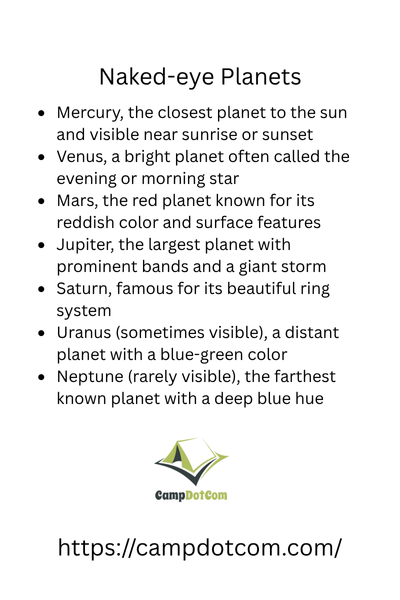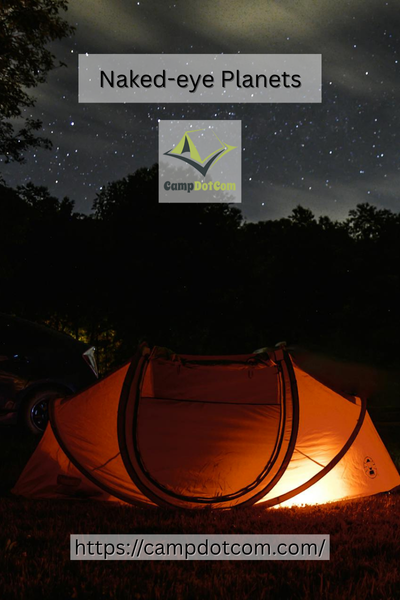The first time I learned about naked eye planets, I thought, Wait, planets you can actually see without any gear? I was hooked. No telescope, no fancy apps, just me, the sky, and a little patience. And trust me, once you start noticing them, it is like unlocking a secret level in the night sky.
Let us talk about how you can do it too.
Read More About Naked-Eye Planets

What Are Naked-Eye Planets, Anyway?
So when we say naked eye planets, we are talking about the five planets you can spot without any visual aid: Mercury, Venus, Mars, Jupiter, and Saturn. Yep, five of them. Easy to remember and totally visible if you know when and where to look.
As an Amazon Associate, I earn from qualifying purchases. Some of the links in this article are affiliate links. This means that, at zero cost to you, I will earn an affiliate commission if you click through the link and finalize a purchase.
They are not tiny dots either (okay, maybe Mercury is a bit shy). These planets shine bright enough to compete with the stars, but there is a trick. They do not twinkle like stars. Instead, they glow with a steady light, like they know they are special.
My First Time Planet-Hunting
I remember standing in my backyard, holding a warm cup of coffee at five AM, wondering why on earth I woke up this early. The forecast said Mars and Jupiter would be visible just before sunrise. I was not sure what I would see, but then I saw it. Two bright points hovering near the horizon. I almost spilled my coffee. They were just there. No telescope, no binoculars. Just my sleepy eyes and a good old fashioned sky.
It felt weirdly empowering. Like I cracked a cosmic code.
How Can You Spot Naked-Eye Planets?
First tip? Timing matters. Some planets are early birds, while others are night owls. Venus, for instance, is often called the “morning star” or “evening star” because it hangs low near sunrise or sunset. Mars tends to play hard to get unless it’s at opposition (basically, when it’s closest to Earth).
More Things to Know About Naked-Eye Planets

If you want a fighting chance at seeing these naked-eye planets, here’s what’s worked for me:
- Check a sky calendar (I use an app called SkySafari, but there are tons out there).
- Find a dark spot away from city lights (even your backyard might work if the lights are low).
- Give your eyes 15 minutes to adjust to the dark—seriously, don’t skip this. Your eyeballs need time to warm up to the dark like an old engine.
- Look along the ecliptic—that’s the imaginary path the Sun and planets follow across the sky. You won’t need to memorize anything; just draw a line from where the Sun rises to where it sets, and boom, that’s your hunting zone.
Can You See All Five at Once?
You actually can, and when that happens—it’s spectacular. These planetary lineups happen every few years, and social media always goes nuts about it. It’s like a celestial reunion tour, and everyone’s invited.
One morning, I dragged my partner outside at 4:30 AM (I bribed him with donuts), and we saw Mercury, Venus, Mars, Jupiter, and Saturn all lined up in a row. He doesn’t geek out about space stuff like I do, but even he let out a “Whoa” that wasn’t donut-related.
Why Bother with Naked-Eye Planets?
You might be wondering, Isn’t it just easier to look at pictures online? Sure, but where’s the fun in that? There’s something primal about looking up and knowing you’re seeing the same planets people saw thousands of years ago.
Ancient civilizations planned their lives around these glowing dots. They tracked them, named them after gods, and built temples to line up with them.
You’re not just stargazing—you’re time traveling, in a way.
Plus, it’s kind of addictive. Once you spot Venus lighting up the horizon like a cosmic headlight, you’ll find yourself stepping outside more often, scanning the skies like a seasoned skywatcher.
Naked-Eye Planets and You
There’s no barrier to entry. No need to buy anything. You’ve already got everything you need—your eyes, your curiosity, and maybe a hoodie because nights can get cold.
Start small. Try spotting Venus or Jupiter—they’re usually the brightest. Work your way to the tougher ones like Mercury (which hides close to the Sun) or Mars (which loves to play “catch me if you can”).
And here’s a fun thought: Next time you’re walking your dog or grabbing the mail at night, look up. There might be a planet winking back at you.
Finding Meaning in the Naked-Eye Planets
Exploring the world of naked eye planets does not require a degree in astronomy. All it takes is a bit of curiosity and the willingness to look up once in a while. Whether you are completely new to skywatching or have tried it before, the night sky always has something surprising to offer.
And who knows? The next time the planets align, you might be the one waking someone up at 4:30 in the morning with a box of donuts.
